Guangxi hydro project starts water storage

The Guangxi Dateng Gorge water conservancy project starts water storage on March 10. [Photo/gxnews.com.cn]
The Dateng Gorge water conservancy project, a landmark project for water conservation and water supply, as well as a key project of the Pearl River Basin located in Guiping, Guigang, Guangxi Zhuang autonomous region, started water storage on March 10.
Its water storage will be carried out in two phases. The first phase is expected to take 10 to 15 days to increase the water level to 44 meters to facilitate navigation and power generation. The second phase will further lift the water level to 52 meters, with a storage capacity of 1.61 billion cubic meters, to enhance the water-security capability and navigation level of the Guangdong-Hong Kong-Macao Greater Bay Area.
With a total investment of 35.74 billion yuan ($5.58 billion), the project started construction in November 2014 and will take heavy responsibilities for flood prevention, shipping, power generation, water replenishment, salt watering, and irrigation after completion.
During the first phase of the water storage project, the water level will be gradually raised on the premise of ensuring the water supply, ecology, and shipping needs of the lower reaches of the Xijiang River.
Water filling tests, ship lock with water debugging, and the trial navigation will be accelerated to resume navigation as soon as possible, thus increasing the navigation level of the Qianjiang River from the current 300-ton level to a 3,000-ton level, the highest level of domestic river shipping in China. The annual transportation capacity will be increased from 13 million tons to 52 million tons.
All three units on the left bank of Xijiang River will provide clean energy for local economic and social development, improve the water conditions for irrigation in dry lands in the central areas of Guangxi, as well as enhance the water-security capacity of the Greater Bay Area.


